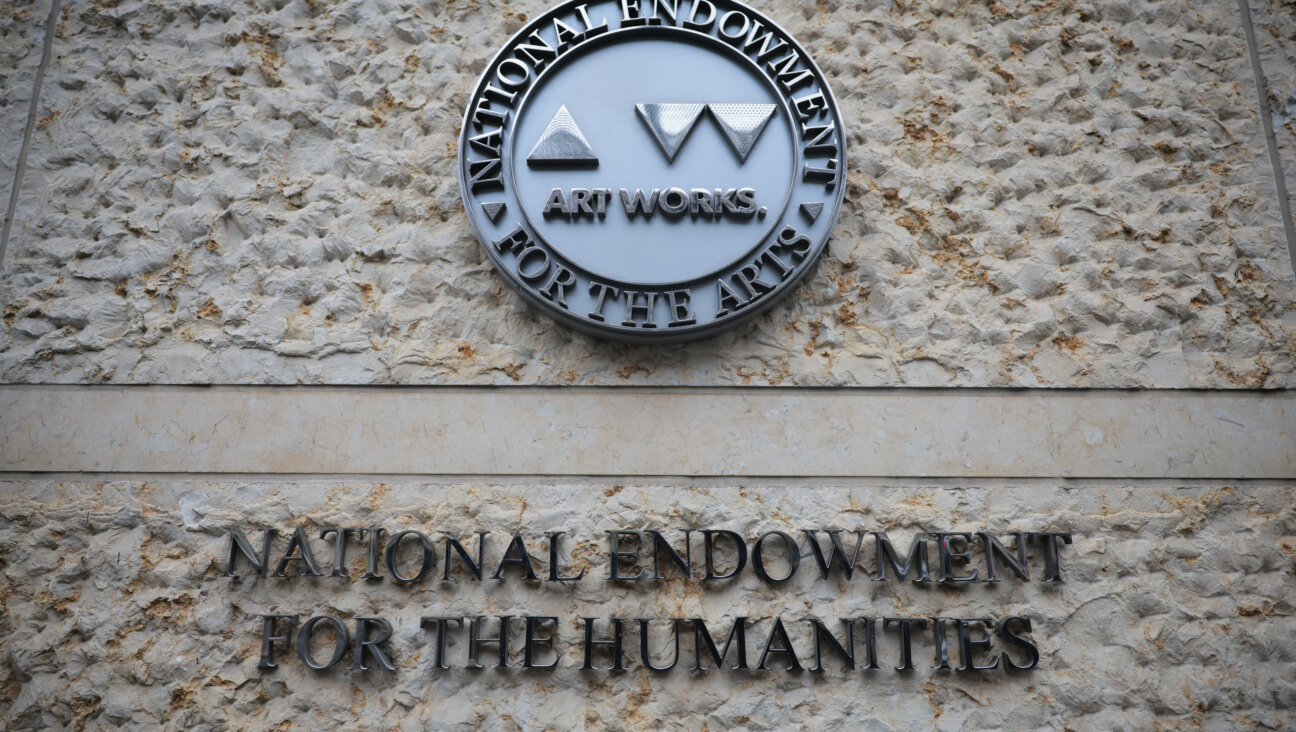This Side of the River Jordan

Where Judea Starts: Jerusalem and part of the West Bank at dusk. Image by NATHANIEL GARNICK
It’s obviously a losing battle, but I can’t help carrying on with the fight. Every time I see an item in the newspaper, like Jackson Diehl’s September 13 column on the current Israeli-Palestinian peace talks in The Washington Post, or Roger Cohen’s column on the same subject in the September 14 New York Times, I want to scream.
Here’s Mr. Diehl:
“Start with [Benjamin] Netanyahu… [his] rhetoric has been rapidly shifting: He’s begun calling [Palestinian President] Abbas ‘a partner for peace’ and using the term ‘West Bank’ rather than the Israeli nationalist term, ‘Judea and Samaria.’”
And here’s Mr. Cohen:
“The old Likudnik’s [Netanyahu’s] biblical reference lingers — Judea and Samaria for the West Bank — but he’s embraced two states because he’s grasped the alternative: more Arabs than Jews in a single state.”
How long will the canard continue to be repeated by supposedly educated journalists that “Judea” and “Samaria” are territorially expansionist terms, resurrected from the time of the Bible by right-wing Jewish settlers and their supporters, for a geographical area whose rightful name is “the West Bank”? When will this idiocy finally stop?
One would like to ask the Diehls, the Cohens and all the others a simple question: In the long centuries after the final redaction of the Hebrew Bible, which took place sometime in the second or first century BCE, what, in their humble opinion, was the hill country south and north of Jerusalem called?
It certainly wasn’t “the West Bank,” a term that is barely 60 years old. A translation of the Arabic ad-difa’a al-gharbiya, “the West Bank” was a coinage introduced in the early 1950s to denote the area of Palestine west of the Jordan River that was annexed by Transjordan — its name now changed to the Hashemite Kingdom of Jordan — following its conquest by King Abdullah’s Arab Legion in the 1948–49 Arab-Israeli war. You won’t find it in a single book, atlas or newspaper article before that.
What will you find? Well, let’s begin with the British period that immediately preceded Israel’s 1948 War of Independence. Having wrested Palestine from the Turks in World War I, and been given a mandate over it by the League of Nations in 1922, Great Britain divided the country that year into administrative districts. There were four of these: a “Southern District,” composed of the Hebron, Beersheba and Gaza sub-districts; a “Jerusalem-Jaffa District,” which included sub-districts for Bethlehem, Jericho and Ramallah; a “Northern District,” whose sub-districts were Acre, Haifa, Nazareth and Safed, and a “Samaria District,” made up of the Baisan (Bet-She’an), Jenin, Nablus and Tulkarm sub-districts. That’s right: The British, whom even Messrs. Cohen and Diehl would not confuse with “Israeli nationalists,” officially called the hill country north of Jerusalem, as far as the Valley of Jezreel, Samaria.
True, the British did not refer to the hill country south of Jerusalem as the “Judea District,” nor did they treat it as a single administrative unit, since the Bethlehem sub-district was grouped with Jerusalem and Jaffa, and the Hebron sub-district with Beersheba and Gaza. One can only imagine what would have been the reaction to “Judea” of the Arab leadership of Palestine, which bitterly opposed putting Eretz-Yisra’el in Hebrew letters besides English “Palestine” and Arabic “Filastin” on official documents, coins and stamps. (The compromise reached in the end was to write, in Hebrew, Palestina, followed by E.Y. — alef-yod — in parentheses.)
And yet, long before the British Mandate, Judea was the standard English word for the hills around Bethlehem and Hebron, just as Samaria was for the hills farther north. Commercial European tourism to Palestine started in the mid-19th century, and from then on, England witnessed a spate of travel books reporting on visits there. All these books use similar terminology. Thus, to take an example that I happen to have on a bookshelf, the Rev. Samuel Manning’s “Those Holy Fields: Palestine Illustrated by Pen and Pencil,” published in London in 1874, has three sections: one on “Southern Palestine, or Judea,” with itineraries from “Jaffa to Hebron,” “Bethlehem to the Dead Sea,” and “Jericho and the Jordan to Jerusalem”; one on “Northern Palestine, or Galilee,” and one on “Central Palestine, or Samaria,” with itineraries from “Jerusalem to Shiloh” and “Nablus to the Plain of Esdraelon.” Manning, needless to say, was a Protestant minister, not a Jewish settler.
One could go back further, to 18th-century maps, and to the 14th-century “Travels of Sir John Mandeville” (which tells us that “Jerusalem is in the land of Judea, and it is clept Judea,” and that “Sichem” — Shechem or Nablus — is “in the province of Samaritans”), and to the fourth-century Church Father Eusebius of Caesaria’s Historica Ecclesiastica. Surely, however, there is no need. Judea and Samaria, although they derive from the Hebrew biblical terms Yehuda and Shomron, have been part of the geographical vocabulary of Christian Europe since the time of Jesus. “The West Bank” has not been.
To refuse to refer to the West Bank as Judea and Samaria is, whether deliberately or not, to declare that Jews and Christians have no historical connection to these areas. To malign others for calling them that is even worse.
Questions for Philologos can be sent to [email protected]
The Forward is free to read, but it isn’t free to produce

I hope you appreciated this article. Before you go, I’d like to ask you to please support the Forward.
Now more than ever, American Jews need independent news they can trust, with reporting driven by truth, not ideology. We serve you, not any ideological agenda.
At a time when other newsrooms are closing or cutting back, the Forward has removed its paywall and invested additional resources to report on the ground from Israel and around the U.S. on the impact of the war, rising antisemitism and polarized discourse.
This is a great time to support independent Jewish journalism you rely on. Make a Passover gift today!
— Rachel Fishman Feddersen, Publisher and CEO
Most Popular
- 1

Opinion My Jewish moms group ousted me because I work for J Street. Is this what communal life has come to?
- 2

Opinion Stephen Miller’s cavalier cruelty misses the whole point of Passover
- 3

Opinion I co-wrote Biden’s antisemitism strategy. Trump is making the threat worse
- 4

Opinion Passover teaches us why Jews should stand with Mahmoud Khalil
In Case You Missed It
-

Culture Jews thought Trump wanted to fight antisemitism. Why did he cut all of their grants?
-

Opinion Trump’s followers see a savior, but Jewish historians know a false messiah when they see one
-

Fast Forward Trump administration can deport Mahmoud Khalil for undermining U.S. foreign policy on antisemitism, judge rules
-

Opinion This Passover, let’s retire the word ‘Zionist’ once and for all
-
Shop the Forward Store
100% of profits support our journalism
Republish This Story
Please read before republishing
We’re happy to make this story available to republish for free, unless it originated with JTA, Haaretz or another publication (as indicated on the article) and as long as you follow our guidelines.
You must comply with the following:
- Credit the Forward
- Retain our pixel
- Preserve our canonical link in Google search
- Add a noindex tag in Google search
See our full guidelines for more information, and this guide for detail about canonical URLs.
To republish, copy the HTML by clicking on the yellow button to the right; it includes our tracking pixel, all paragraph styles and hyperlinks, the author byline and credit to the Forward. It does not include images; to avoid copyright violations, you must add them manually, following our guidelines. Please email us at [email protected], subject line “republish,” with any questions or to let us know what stories you’re picking up.















